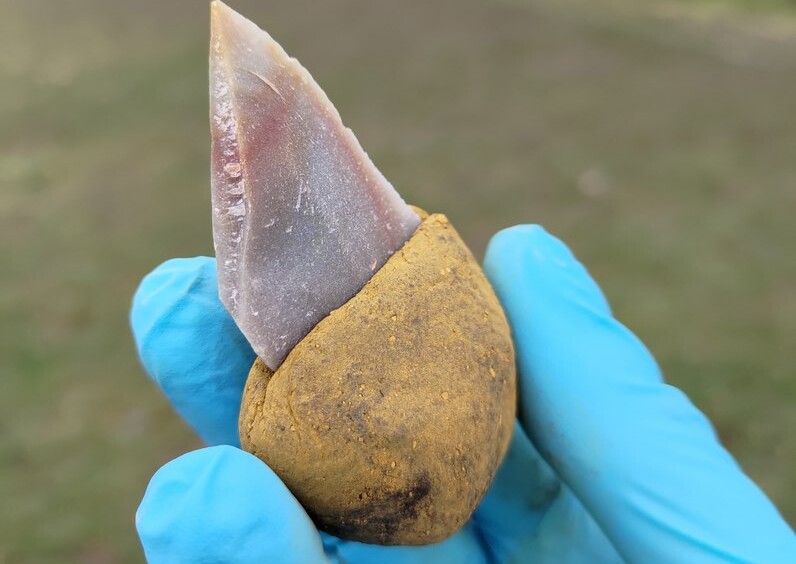
Neanderthals created stone tools held together with a glue made from scratch, a team of scientists has discovered.
They are the earliest evidence of a complex adhesive in Europe, suggest these predecessors to modern humans had a higher level of cognition and cultural development than previously thought.
The stone tools from an archaeological site in Le Moustier, France, were used by Neanderthals during the Middle Paleolithic period of the Mousterian between 120,000 and 40,000 years ago. Kept in the collection of Berlin’s Museum of Prehistory and Early History, they had not previously been examined in detail.
The tools were rediscovered during an internal review of the collection and their scientific value was recognized.
“The items had been individually wrapped and untouched since the 1960s,” said Ewa Dutkiewicz, from the Berlin museum. “As a result, the adhering remains of organic substances were very well preserved.”
The researchers discovered traces of a mixture of ochre and bitumen on several stone tools, such as scrapers, flakes, and blades. Ochre is a naturally occurring earth pigment; bitumen is a component of asphalt and can be produced from crude oil, but also occurs naturally in the soil.
“We were surprised that the ochre content was more than 50%,” said Patrick Schmidt from the University of Tübingen’s Early Prehistory and Quaternary Ecology section, who lead the reseach.
“This is because air-dried bitumen can be used unaltered as an adhesive, but loses its adhesive properties when such large proportions of ochre are added.”
He and his team examined these materials in tensile tests—used to determine strength—and other measures.
“It was different when we used liquid bitumen, which is not really suitable for gluing. If 55 percent ochre is added, a malleable mass is formed,” Schmidt says.
The mixture was just sticky enough for a stone tool to remain stuck in it, but without adhering to hands, making it suitable material for adding a convenient handle to a small blade of flint—like a cheese knife—allowing for much greater manipulation of the small tool by thick Neanderthal hands.
“The tools showed two kinds of microscopic wear: one is the typical polish on the sharp edges that is generally caused by working other materials,” explains Radu Iovita, an associate professor at NYU’s Center for the Study of Human Origins, who conducted this analysis.
MORE NEANDERTHAL TECH: Remains of Prehistoric BBQ Suggests Dinner was Served 780,000 Years Ago–600,000 Years Earlier than we Thought
“The other is a bright polish distributed all over the presumed hand-held part, but not elsewhere, which we interpreted as the results of abrasion from the ochre due to movement of the tool within the grip.”
The use of adhesives with several components, including various sticky substances such as tree resins and ochre, was previously known from early modern humans, Homo sapiens, in Africa but not from earlier Neanderthals in Europe. Overall, the development of adhesives and their use in the manufacture of tools is considered to be some of the best material evidence of the cultural evolution and cognitive abilities of early humans.
OTHER TECHNOLOGY THAT GOES WAY BACK: Thousands of Years Ago, a Woman Underwent Two Surgeries to Her Head–and Survived Both Procedures
“Compound adhesives are considered to be among the first expressions of the modern cognitive processes that are still active today,” says Schmidt.
In the Le Moustier region, ochre and bitumen had to be collected from distant locations, which meant a great deal of effort, planning, and a targeted approach, the authors note.
“What our study shows is that early Homo sapiens in Africa and Neanderthals in Europe had similar thought patterns,” adds Schmidt. “Their adhesive technologies have the same significance for our understanding of human evolution.”
The study was published in Science Advances.
DO Your Friends Know That Neanderthals Invented Glue? SHARE The News…



















